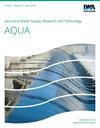A catastrophe identification method for rainfall time series coupled sequential Mann-Kendall algorithm and Bernaola Galvan algorithm: a case study of the Qinglong River watershed, China
IF 4.3
Q2 Environmental Science
引用次数: 0
Abstract
The identification of rainfall catastrophe characteristics is important for rainfall consistency testing in hydrostatistical analysis. In this study, a new classification framework method (trend, mean and change-rate catastrophe) coupled Sequential Mann-Kendall (SQ-MK) algorithm and Bernaola-Galvan heuristic segmentation (B-G) algorithm was proposed, and a rainfall catastrophe identification scheme was carried out for the Qinglong River watershed, Northern China. Meanwhile, the accuracy of catastrophe identification was improved by the robustness of the algorithm and the parameter optimization method of the B-G algorithm. Results revealed that (1) the most significant point of trend catastrophe in the Qinglong River watershed was in 1997. The trend catastrophe identification based on the SQ-MK algorithm was sensitive to the length of time series. (2) The sensitivity of parameter P0 (Range value (R) = 2.889) in the B-G algorithm was greater than that of parameter l0 (R = 0.333). The mean catastrophe points for the Qinglong River watershed were in 1997, 2002 and 2009. (3) The mean catastrophe identification based on the B-G algorithm was insensitive to the length of time series. (4) There was no change-rate catastrophe point in the Qinglong River watershed. Trend catastrophe and mean catastrophe did not necessarily lead to change-rate catastrophe.降雨时间序列耦合序列Mann-Kendall算法和Bernaola Galvan算法的突变识别方法——以青龙河流域为例
降雨突变特征的识别是水文统计分析中降雨一致性检验的重要内容。本文提出了一种新的分类框架方法(趋势、均值和变化率突变),结合序列Mann-Kendall (SQ-MK)算法和Bernaola-Galvan启发式分割(B-G)算法,对青龙河流域进行了降雨突变识别方案。同时,利用算法的鲁棒性和B-G算法的参数优化方法,提高了突变识别的准确性。结果表明:(1)青龙河流域趋势突变的最显著点是1997年。基于SQ-MK算法的趋势突变识别对时间序列长度敏感。(2) B-G算法中参数P0 (Range value (R) = 2.889)的灵敏度大于参数l0 (R = 0.333)。青龙河流域的平均灾变点分别为1997年、2002年和2009年。(3)基于B-G算法的平均突变识别对时间序列长度不敏感。(4)青龙河流域不存在变化率突变点。趋势突变和平均突变不一定导致变化率突变。
本文章由计算机程序翻译,如有差异,请以英文原文为准。
求助全文
约1分钟内获得全文
求助全文
来源期刊
CiteScore
4.70
自引率
0.00%
发文量
74
审稿时长
4.5 months
期刊介绍:
Journal of Water Supply: Research and Technology - Aqua publishes peer-reviewed scientific & technical, review, and practical/ operational papers dealing with research and development in water supply technology and management, including economics, training and public relations on a national and international level.

 求助内容:
求助内容: 应助结果提醒方式:
应助结果提醒方式:


